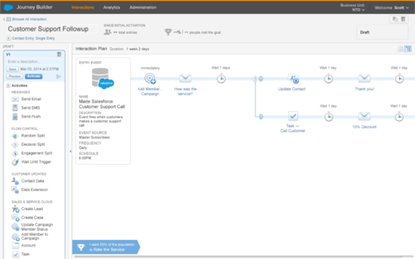Salesforce Marketing Cloud aims to blur the lines between marketing, sales and service
- 18 June, 2015 04:11

Salesforce Journey Builder
Marketers have long struggled with the challenge of engaging customers across channels, but an updated version of Salesforce's Marketing Cloud could help.
Unveiled on Wednesday, the new software offers several enhancements designed to give companies a single place for planning customer "journeys," or managing their interactions with a brand across sales, service, marketing and more. It also aims to make it easier for marketers to orchestrate ad targeting across the digital advertising ecosystem.
First, Marketing Cloud's updated Journey Builder tool promises to give marketers the ability to guide customers on journeys across channels and devices and ensure that those customers always get the right message in the right place at the right time. Essentially, it does that by enabling companies to connect every interaction customers have with their brand across every department, making it easier to see and manage the overall picture.
New pre-built Sales Cloud and Service Cloud events and activities in Journey Builder are part of the new capabilities making those cross-channel integrations possible. So, too, are new pre-built Journey Triggers, which enable marketers to automate inbound event-driven triggers, such as a customer joining a loyalty program or downloading an app, so that the customer is automatically sent a message on any channel. Triggers can also automatically modify data in the customer contact record or set up wait times to adjust the journey in real-time based on customer interactions across sales, marketing and service.
"The most important issue in digital marketing is for the marketer to understand where the customer is in his or her journey," said Denis Pombriant, managing principal at Beagle Research Group. "We think we know these things, but what we know is based on assumptions, and while some assumptions are on target, many others are not."
The result is that vendors can miss critical opportunities, Pombriant added.
"Journey mapping via Journey Builder enables us to do away with pure assumptions by replacing them with testable hypotheses about reality," he said.
The updated tool also extends the journey-mapping process beyond marketing and into the front office, Pombriant noted, making it easier to maintain a consistent customer focus.
Related: Salesforce brings customer strategy mapping to mobile apps
The second newly updated piece of Marketing Cloud is its Active Audiences ad platform, which syncs ad targeting with CRM to help marketers run more relevant ads wherever they execute campaigns.
New partnerships with companies including LiveRamp, LiveIntent, Neustar and Viant aim to empower Salesforce users to activate CRM data and run ads across more than 100 digital advertising networks and technologies.
Full integration with Journey Builder, meanwhile, helps marketers coordinate their advertising efforts with customers' entire brand experience, including their purchase history, engagement with customer service teams, emails and mobile messages opened, and where they fall in the sales cycle.
Finally, through Salesforce's partnerships with Facebook and Twitter, Active Audiences now enables marketers to reach customers and prospects on those social sites.
Salesforce Marketing Cloud and Journey Builder are generally available today for customers. Journey Builder pricing starts at $3,750 per month. New Journey Builder activities, triggers and events with Sales Cloud and Service Cloud will be available in the fourth quarter of this year.
Active Audiences, meanwhile, is generally available today for customers. New Active Audiences display features are expected to be generally available in the third quarter. Active Audiences pricing starts at $4,200 per month.

